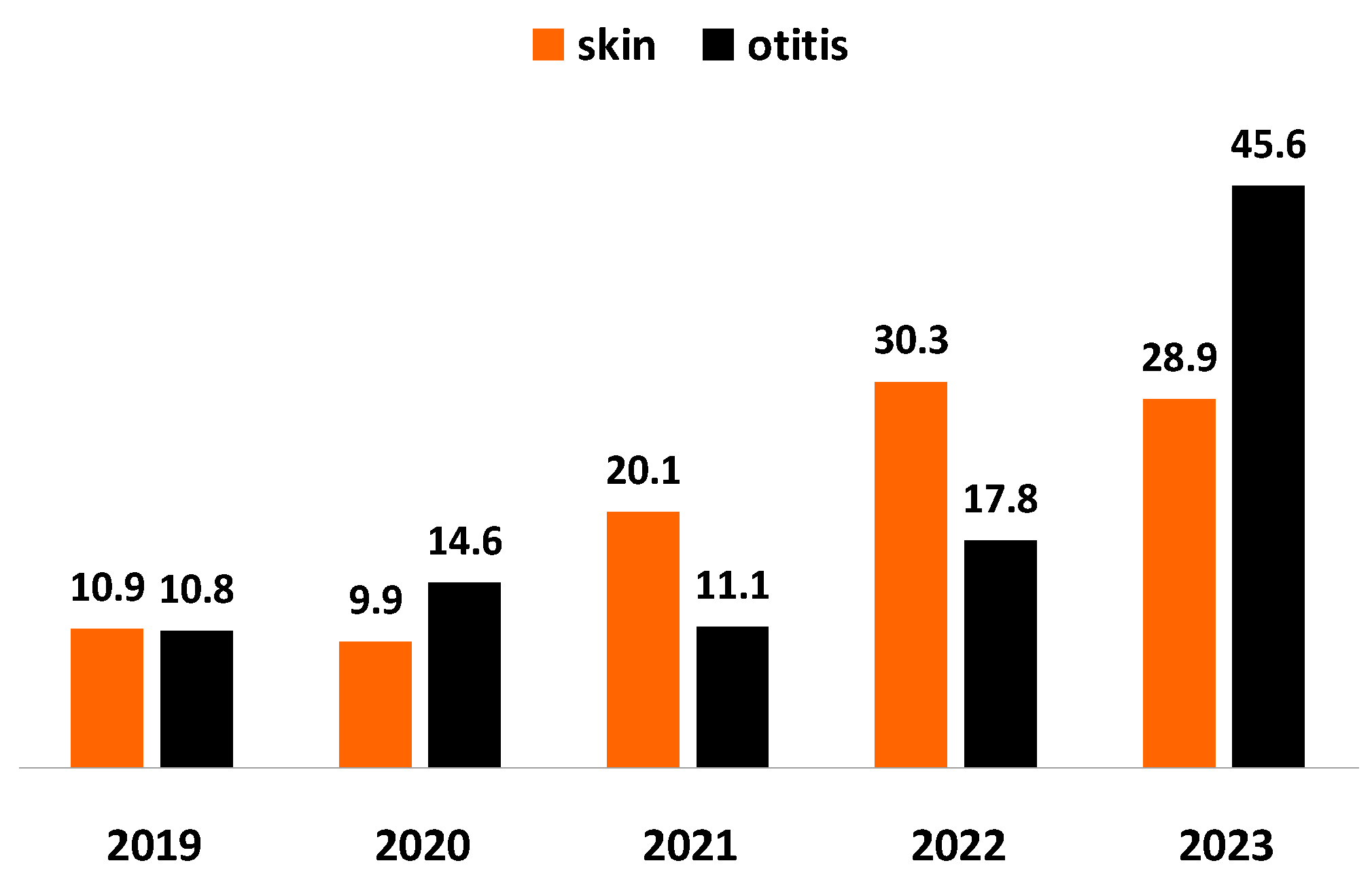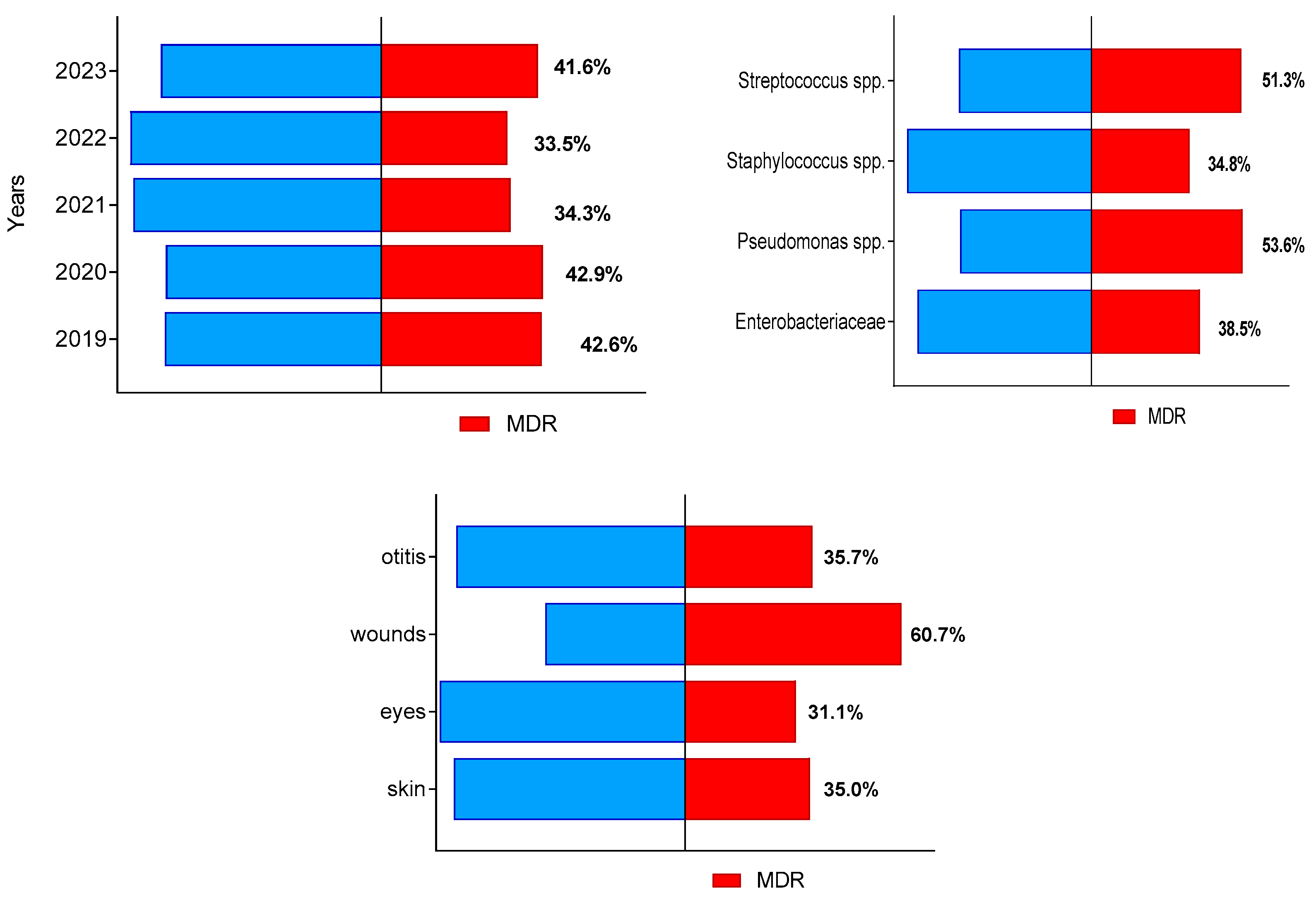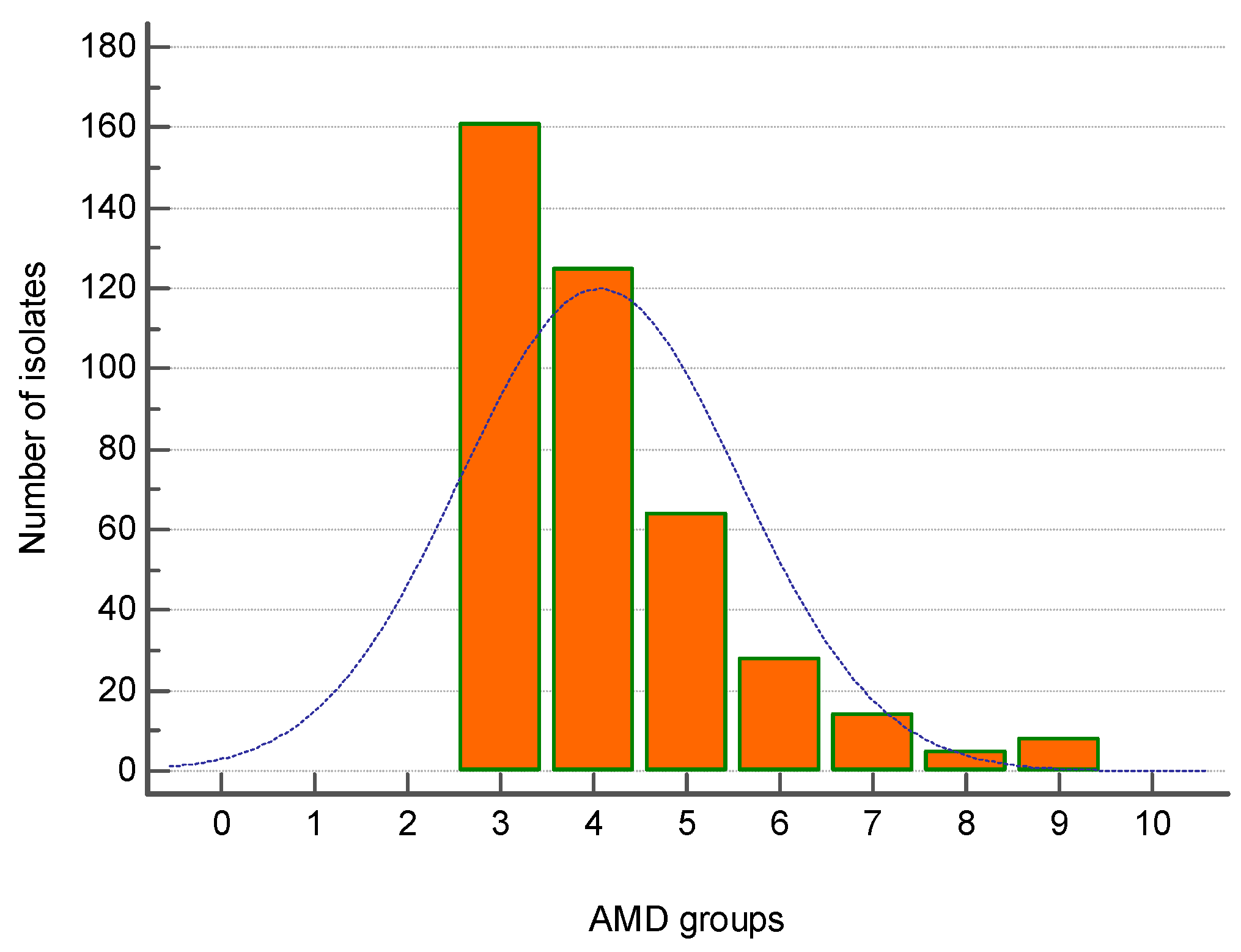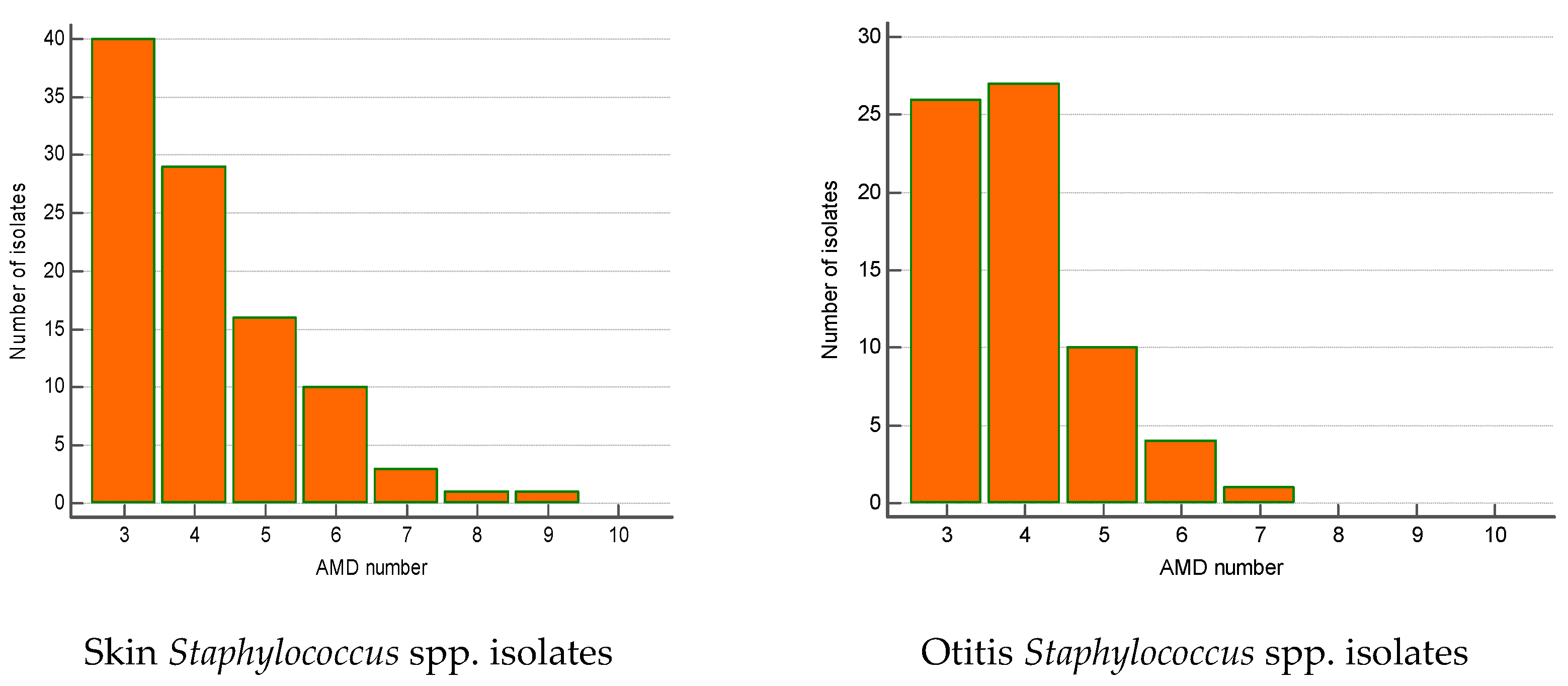A Retrospective Study (2019–2023) on the Prevalence and Antimicrobial Resistance of Isolates from Canine Clinical Samples Submitted to the University Veterinary Hospital in Stara Zagora, Bulgaria
Abstract
:1. Introduction
2. Materials and Methods
2.1. Ethics Statement
2.2. Samples
2.3. Microbiological Examination and Identification of Isolates
2.4. Antimicrobial Susceptibility Testing
2.5. Data Analysis
3. Results
3.1. Microorganisms Associated with Infections in Dogs
3.2. Patterns of Antimicrobial Drug Resistance
4. Discussion
Supplementary Materials
Author Contributions
Funding
Data Availability Statement
Acknowledgments
Conflicts of Interest
References
- Gee, N.R.; Rodriguez, K.E.; Fine, A.H.; Trammell, J.P. Dogs Supporting Human Health and Well-Being: A Biopsychosocial Approach. Front. Vet. Sci. 2021, 8, 630465. [Google Scholar] [CrossRef]
- Martins, E.; Maboni, G.; Battisti, R.; da Costa, L.; Selva, H.L.; Levitzki, E.D.; Gressler, L.T. High rates of multidrug resistance in bacteria associated with small animal otitis: A study of cumulative microbiological culture and antimicrobial susceptibility. Microb. Pathog. 2022, 165, 105399. [Google Scholar] [CrossRef]
- Santaniello, A.; Sansone, M.; Fioretti, A.; Menna, L.F. Systematic review and meta-analysis of the occurrence of ESKAPE bacteria group in dogs, and the related zoonotic risk in animal-assisted therapy, and in animal-assisted activity in the health context. Int. J. Environ. Res. Public Health 2020, 17, 3278. [Google Scholar] [CrossRef] [PubMed]
- Caneschi, A.; Bardhi, A.; Barbarossa, A.; Zaghini, A. The use of antibiotics and antimicrobial resistance in veterinary medicine, a complex phenomenon: A narrative review. Antibiotics 2023, 12, 487. [Google Scholar] [CrossRef] [PubMed]
- Štempelová, L.; Kubašová, I.; Bujňáková, D.; Kačírová, J.; Farbáková, J.; Maďar, M.; Karahutová, L.; Strompfová, V. Distribution and characterization of staphylococci isolated from healthy canine skin. Top. Companion Anim. Med. 2022, 49, 100665. [Google Scholar] [CrossRef]
- Nocera, F.P.; Ambrosio, M.; Fiorito, F.; Cortese, L.; De Martino, L. On Gram-positive- and Gram-negative-bacteria-associated canine and feline skin infections: A 4-year retrospective study of the University Veterinary Microbiology Diagnostic Laboratory of Naples, Italy. Animals 2021, 11, 1603. [Google Scholar] [CrossRef] [PubMed]
- Li, Y.; Fernández, R.; Durán, I.; Molina-López, R.A.; Darwich, L. Antimicrobial resistance in bacteria isolated from cats and dogs from the Iberian Peninsula. Front. Microbiol. 2021, 11, 621597. [Google Scholar] [CrossRef] [PubMed]
- Marchetti, L.; Buldain, D.; Gortari Castillo, L.; Buchamer, A.; Chirino-Trejo, M.; Mestorino, N. Pet and stray dogs as reservoirs of antimicrobial-resistant Escherichia coli. Int. J. Microbiol. 2021, 2021, 6664557. [Google Scholar] [CrossRef] [PubMed]
- Conner, J.G.; Smith, J.; Erol, E.; Locke, S.; Phillips, E.; Carter, C.N.; Odoi, A. Temporal trends and predictors of antimicrobial resistance among Staphylococcus spp. isolated from canine specimens submitted to a diagnostic laboratory. PLoS ONE 2018, 13, e0200719. [Google Scholar] [CrossRef]
- Gómez-Beltrán, D.A.; Villar, D.; López-Osorio, S.; Ferguson, D.; Monsalve, L.K.; Chaparro-Gutiérrez, J.J. Prevalence of antimicrobial resistance in bacterial isolates from dogs and cats in a Veterinary Diagnostic Laboratory in Colombia from 2016–2019. Vet. Sci. 2020, 7, 173. [Google Scholar] [CrossRef]
- Leet-Otley, K.; Fellman, C.L.; Wayne, A.S.; Beaulac, K.; DeStefano, I.M.; Chambers, K.; Marino, K.B.; Doron, S. Demonstrating the importance of local culture and susceptibility data: Antibiograms from dogs at a veterinary tertiary care center. J. Am. Vet. Med. Assoc. 2023, 261, 1–7. [Google Scholar] [CrossRef] [PubMed]
- Petrov, V.; Mihaylov, G.; Tsachev, I.; Zhelev, G.; Marutsov, P. Otitis externa in dogs: Microbiology and antimicrobial susceptibility. Revue Méd. Vét. 2013, 164, 18–22. [Google Scholar]
- Terziev, G.; Urumova, V. Retrospective study on the etiology and clinical signs of canine otitis. Comp. Clin. Pathol. 2018, 27, 7–12. [Google Scholar] [CrossRef]
- Petrov, V.; Zhelev, G.; Marutsov, P.; Koev, K.; Georgieva, S.; Toneva, I.; Urumova, V. Microbiological and antibacterial resistance profile in canine otitis externa—A comparative analysis. Bulg. J. Vet. Med. 2019, 22, 447–456. [Google Scholar] [CrossRef]
- Markey, B.; Leonard, F.; Archambault, M.; Cullinane, A.; Maguire, D. Clinical Veterinary Microbiology, 2nd ed.; Elsevier: Edinburgh, UK, 2013. [Google Scholar]
- CLSI. Performance Standards for Antimicrobial Disk and Dilution Susceptibility Tests for Bacteria Isolated From Animals, 5th ed.; CLSI Standard VET01; Clinical Laboratory and Standards Institute: Wayne, PA, USA, 2018. [Google Scholar]
- Magiorakos, A.P.; Srinivasan, A.; Carey, R.B.; Carmeli, Y.; Falagas, M.E.; Giske, C.G.; Harbarth, S.; Hindler, J.F.; Kahlmeter, G.; Olsson-Liljequist, B.; et al. Multidrug-resistant, extensively drug-resistant and pandrug-resistant bacteria: An international expert proposal for interim standard definitions for acquired resistance. Clin. Microbiol. Infect. 2012, 18, 268–281. [Google Scholar] [CrossRef] [PubMed]
- Guardabassi, L.; Damborg, P.; Stamm, I.; Kopp, P.A.; Broens, E.M.; Toutain, P.L.; ESCMID Study Group for Veterinary Microbiology. Diagnostic microbiology in veterinary dermatology: Present and future. Vet. Dermatol. 2017, 28, 146-e30. [Google Scholar] [CrossRef] [PubMed]
- Rosales, R.S.; Ramírez, A.S.; Moya-Gil, E.; de la Fuente, S.N.; Suárez-Pérez, A.; Poveda, J.B. Microbiological survey and evaluation of antimicrobial susceptibility patterns of microorganisms obtained from suspect cases of canine otitis externa in Gran Canaria, Spain. Animals 2024, 14, 742. [Google Scholar] [CrossRef] [PubMed]
- Bajwa, J. Malassezia species and its significance in canine skin disease. Can. Vet. J. 2023, 64, 87–90. [Google Scholar]
- Tesin, N.; Stojanovic, D.; Stancic, I.; Kladar, N.; Ružić, Z.; Spasojevic, J.; Tomanic, D.; Kovacevic, Z. Prevalence of the microbiological causes of canine otitis externa and the antibiotic susceptibility of the isolated bacterial strains. Pol. J. Vet. Sci. 2023, 26, 449–459. [Google Scholar] [CrossRef]
- Qekwana, D.N.; Oguttu, J.W.; Sithole, F.; Odoi, A. Burden and predictors of S. aureus and S. pseudintermedius infections among dogs presented at an academic veterinary hospital in South Africa (2007–2012). Peer J. 2017, 5, e3198. [Google Scholar] [CrossRef]
- Awosile, B.B.; Mcclure, J.T.; Saab, M.E.; Heider, L.C. Antimicrobial resistance in bacteria isolated from cats and dogs from the Atlantic Provinces, Canada from 1994–2013. Can. Vet. J. 2018, 59, 885–893. [Google Scholar] [PubMed]
- Yılmaz, K.N.; Baş, B. Superficial pyoderma in cats and dogs: A retrospective clinical study. Ankara Univ. Vet. Fak. Derg. 2024, 71, 207–213. [Google Scholar] [CrossRef]
- Bourély, C.; Cazeau, G.; Jarrige, N.; Leblond, A.; Madec, J.Y.; Haenni, M.; Gay, E. Antimicrobial resistance patterns of bacteria isolated from dogs with otitis. Epidemiol. Infect. 2019, 147, e121. [Google Scholar] [CrossRef] [PubMed]
- Secker, B.; Shaw, S.; Atterbury, R.J. Pseudomonas spp. in canine otitis externa. Microorganisms 2023, 11, 2650. [Google Scholar] [CrossRef] [PubMed]
- Arain, M.B.; Ambreen, L.; Muhammad, K.F.; Muhammad, F.H.; Ahmed, L.S.; Salam, K.A.; Ismail, M.M.; Zainab, L.; Ur, R.I.; Shahzeb, A. Prevalence and characterization of in vitro susceptibility profile of bacteria harvested from otitis externa in dogs. Pak-Euro J. Med. Life Sci. 2024, 7, 103–110. [Google Scholar]
- Kožár, M.; Hamilton, H.; Koščová, J. Types of wounds and the prevalence of bacterial contamination of wounds in the clinical practice of small animals. Folia Vet. 2018, 62, 39–47. [Google Scholar] [CrossRef]
- Corsini, C.M.M.; Silva, V.O.; Carvalho, O.V.; Sepúlveda, R.V.; Valente, F.L.; Reis, E.C.C.; Moreira, M.A.S.; Silva Júnior, A.; Borges, A.P.B. Emergence of multidrug-resistant bacteria isolated from surgical site infection in dogs and cats. Arq. Bras. Med. Vet. Zootec. 2020, 72, 1213–1220. [Google Scholar] [CrossRef]
- Kizerwetter-Świda, M.; Chrobak-Chmiel, D.; Stefańska, I.; Kwiecień, E.; Rzewuska, M. In vitro activity of selected antimicrobials against methicillin-resistant Staphylococcus pseudintermedius of canine origin in Poland. Vet. Med. Sci. 2024, 10, e1385. [Google Scholar] [CrossRef]
- Ludwig, C.; de Jong, A.; Moyaert, H.; El Garch, F.; Janes, R.; Klein, U.; Morrissey, I.; Thiry, J.; Youala, M. Antimicrobial susceptibility monitoring of dermatological bacterial pathogens isolated from diseased dogs and cats across Europe (ComPath results). J. Appl. Microbiol. 2016, 121, 1254–1267. [Google Scholar] [CrossRef]
- Lenart-Boroń, A.; Stankiewicz, K.; Czernecka, N.; Ratajewicz, A.; Bulanda, K.; Heliasz, M.; Sosińska, D.; Dworak, K.; Ciesielska, D.; Siemińska, I.; et al. Wounds of companion animals as a habitat of antibiotic-resistant bacteria that are potentially harmful to humans-phenotypic, proteomic and molecular detection. Int. J. Mol. Sci. 2024, 25, 3121. [Google Scholar] [CrossRef]
- Moerer, M.; Lübke-Becker, A.; Bethe, A.; Merle, R.; Bäumer, W. Occurrence of antimicrobial resistance in canine and feline bacterial pathogens in Germany under the Impact of the TÄHAV amendment in 2018. Antibiotics 2023, 12, 1193. [Google Scholar] [CrossRef] [PubMed]
- Marco-Fuertes, A.; Marin, C.; Gimeno-Cardona, C.; Artal-Muñoz, V.; Vega, S.; Montoro-Dasi, L. Multidrug-resistant commensal and infection-causing Staphylococcus spp. isolated from companion animals in the Valencia region. Vet. Sci. 2024, 11, 54. [Google Scholar] [CrossRef] [PubMed]
- Andonova, M.; Urumova, V. Immune surveillance mechanisms of the skin against the stealth infection strategy of Pseudomonas aeruginosa—Review. Comp. Immunol. Microbiol. Infect. Dis. 2013, 36, 433–448. [Google Scholar] [CrossRef] [PubMed]
- Deb, P.; Das, T.; Nath, C.; Ahad, A.; Chakraborty, P. Isolation of multidrug-resistant Escherichia coli, Staphylococcus spp., and Streptococcus spp. from dogs in Chattogram Metropolitan Area, Bangladesh. J. Adv. Vet. Anim. Res. 2020, 7, 669–677. [Google Scholar] [CrossRef]
- Lord, J.; Millis, N.; Jones, R.D.; Johnson, B.; Kania, S.A.; Odoi, A. Patterns of antimicrobial, multidrug and methicillin resistance among Staphylococcus spp. isolated from canine specimens submitted to a diagnostic laboratory in Tennessee, USA: A descriptive study. BMC Vet. Res. 2022, 18, 91. [Google Scholar] [CrossRef]







| Groups of Microorganisms | Year of Study | Total | ||||
|---|---|---|---|---|---|---|
| 2019 | 2020 | 2021 | 2022 | 2023 | ||
| Staphylococcus spp. | 80 | 92 | 131 | 173 | 214 | 690 |
| Streptococcus spp. | 22 | 18 | 22 | 27 | 24 | 113 |
| Enterobacteriaceae | 14 | 28 | 23 | 22 | 30 | 117 |
| Pseudomonas spp. | 13 | 15 | 13 | 10 | 18 | 69 |
| Other bacteria * | 7 | 10 | 15 | 1 | 24 | 57 |
| Yeasts | 25 | 34 | 34 | 39 | 69 | 201 |
| Total | 161 | 197 | 238 | 272 | 379 | 1247 |
| Throat | Eyes | Nose | Ears | Skin | Wounds | Total | |
|---|---|---|---|---|---|---|---|
| Staphylococcus spp. | 2 | 56 | 8 | 247 | 294 | 83 | 690 |
| Streptococcus spp. | 3 | 21 | 3 | 39 | 25 | 22 | 113 |
| Enterobacteriaceae | 2 | 6 | 6 | 63 | 21 | 19 | 117 |
| Pseudomonas spp. | 2 | 10 | 1 | 43 | 8 | 5 | 69 |
| Other bacteria * | 4 | 13 | 8 | 20 | 6 | 6 | 57 |
| Yeasts | − | − | − | 189 | 12 | – | 201 |
| Total | 13 | 106 | 26 | 601 | 366 | 135 | 1247 |
| Staphylococcus spp. | Streptococcus spp. | Enterobacteriaceae | Pseudomonas spp. | |||||
|---|---|---|---|---|---|---|---|---|
| Antibiotic | Isolates Tested | % Resistant (95% CI) | Isolates Tested | % Resistant (95% CI) | Isolates Tested | % Resistant (95% CI) | Isolates Tested | % Resistant (95% CI) |
| Amoxicillin/CA | 649 | 14.9 (12.2–18.2) | 104 | 13.5 (8.2–21.3) | 109 | 19.3 (13–27.7) | 53 | 94.3 (84.6–98.1) |
| Cephalexin | 393 | 14.8 (11.2–19.1) | 49 | 28.6 (17.9–42.4) | 41 | 51.2 (36.5–65.8) | 11 | 81.8 (52.3–94.9) |
| Cefovecin | 32 | 34.4 (17.2–61.5) | 9 | 44.4 (18.9–73.3) | 7 | 57.1 (25–84.2) | 3 | 100 (43.9–100) |
| Cefquinome | 416 | 9.6 (6.9–13.1) | 81 | 19.2 (12.8–27.8) | 95 | 15.8 (9.8–24.4) | 53 | 49.1 (36.1–62.1) |
| Enrofloxacin | 543 | 28.7 (24.4–33.6) | 88 | 81.8 (72.5–88.5) | 100 | 24 (16.7–33.2) | 62 | 32.8 (22.3–45.3) |
| Marbofloxacin | 426 | 37.3 (31.8–43.6) | 78 | 85.9 (76.5–91.9) | 103 | 18.4 (12.1–27) | 61 | 31.1 (20.9–43.6) |
| Levofloxacin | 30 | 23.3 (9.4–48.1) | 6 | 66.7 (30–90.3) | 6 | 16.7 (3.0–56.3) | 7 | 0 (0–35.4) |
| Orbifloxacin | 228 | 45.6 (37.3–55.3) | 36 | 94.4 (81.9–98.5) | 55 | 36.4 (24.9–49.6) | 40 | 70 (54.6–81.9) |
| Gentamicin | 673 | 17.1 (14.1–20.5) | 111 | 18.9 (12.7–27.2) | 116 | 13.8 (8.7–21.2) | 69 | 5.8 (2.3–13.9) |
| Amikacin | 303 | 19.8 (15.1–25.5) | 75 | 64 (52.7–73.9) | 83 | 21.7 (14.2–31.7) | 61 | 14.8 (7.9–25.7) |
| Neomycin | 18 | 33.3 (12.2–72.6) | 5 | 60 (23.1–88.2) | 8 | 37.5 (13.7–69.4) | 6 | 16.7 (3.0–56.3) |
| Tobramycin | 124 | 11.3 (6.2–18.9) | 31 | 22.6 (11.4–39.8) | 22 | 4.6 (0.8–21.8) | 33 | 3.0 (0.5–15.3) |
| Clarithromycin | 104 | 52.9 (39.8–68.8) | 13 | 69.2 (42.4–87.3) | – | – | – | – |
| Azithromycin | 89 | 52.8 (38.8–70.2) | 8 | 50 (21.5–78.5) | − | − | – | – |
| Colistin | 150 | 62.7 (50.6–76.7) | 21 | 76.2 (54.9–89.4) | 39 | 74.4 (58.9–85.4) | 18 | 22.2 (9.0–45.1) |
| Doxycycline | 279 | 36.9 (30.1–44.8) | 39 | 61.5 (45.9–75.1) | 25 | 76 (56.6–88.5) | 9 | 100 (70.1–100) |
| Lincomycin | 123 | 62.6 (49.4–78.2) | 9 | 44.4 (18.9–73.3) | – | – | – | – |
| Lincospectin | 406 | 56.9 (49.8–64.7) | 82 | 51.2 (40.6–61.7) | 85 | 84.7 (75.6–90.8) | 29 | 93.1 (78–98.1) |
| Clindamycin | 141 | 59.6 (47.5–73.8) | 20 | 70 (48.1–85.5) | 8 | 100 (59.8–100) | – | – |
| Chlorampehicol | 294 | 36.7 (30.1–44.3) | 60 | 25 (15.8–37.2) | 46 | 34.8 (22.7–49.2) | 26 | 73.1 (53.9–86.3) |
| Rifampin | 12 | 16.7 (2.0–60.2) | – | – | – | – | – | – |
| ST | 243 | 40.3 (32.7–49.2) | 28 | 46.4 (29.5–64.2) | 26 | 42.3 (25.5–61.1) | 5 | 100 (56.6–100) |
| Antibiotic | Isolates Tested (% Resistant) | ||||
|---|---|---|---|---|---|
| 2019 | 2020 | 2021 | 2022 | 2023 | |
| Amoxicillin/CA | 31 (14.9) | 27 (17.2) | 27 (13.0) | 65 (8.9) | 94 (20.4) |
| Cephalexin | 36 (8.3) | 43 (14.0) | 77 (11.7) | 125 (11.2) | 112 (23.2) |
| Cefovecin | 7 (28.6) | 13 (30.8) | 10 (50.0) | 2 (0) | − |
| Cefquinome | 52 (5.8) | 69 (20.3) | 101 (6.9) | 98 (8.2) | 96 (8.3) |
| Enrofloxacin | 66 (31.8) | 82 (32.9) | 120 (29.2) | 129 (24.0) | 146 (28.8) |
| Marbofloxacin | 59 (33.9) | 67 (40.3) | 85 (36.5) | 64 (40.6) | 151 (36.6) |
| Orbifloxacin | 28 (50.0) | 42 (40.5) | 29 (48.3) | 47 (31.9) | 82 (53.7) |
| Gentamicin | 77 (18.2) | 88 (26.1) | 124 (16.1) | 172 (20.3) | 212 (10.8) |
| Amikacin | 35 (37.1) | 49 (26.5) | 65 (12.3) | 49 (18.4) | 105 (16.2) |
| Tobramycin | 6 (33.3) | 20 (5.0) | 20 (0) | 23 (26.1) | 55 (9.1) |
| Clarithromycin | 8 (75.0) | 14 (35.7) | 22 (63.6) | 29 (31.0) | 31 (67.7) |
| Azithromycin | − | 9 (55.6) | 10 (80.0) | 27 (40.7) | 43 (53.5) |
| Colistin | 14 (42.9) | 28 (53.6) | 13 (38.5) | 35 (45.7) | 60 (86.7) |
| Doxycycline | 34 (55.9) | 25 (40.0) | 52 (38.5) | 87 (28.7) | 81 (35.8) |
| Lincomycin | 21 (66.7) | 12 (58.3) | 14 (71.4) | 31 (61.3) | 45 (60.0) |
| Lincospectin | 41 (63.4) | 55 (60.0) | 92 (56.5) | 113 (46.9) | 105 (63.8) |
| Clindamycin | 15 (73.3) | 15 (60.0) | 43 (72.9) | 59 (47.5) | 9 (55.6) |
| Chlorampehicol | 29 (31.0) | 35 (34.3) | 49 (42.9) | 97 (39.2) | 84 (33.3) |
| ST | 30 (40.0) | 27 (37.0) | 27 (63.3) | 65 (20.0) | 94 (48.9) |
| Antibiotic | Isolates Tested (% Resistant) | ||||
|---|---|---|---|---|---|
| 2019 | 2020 | 2021 | 2022 | 2023 | |
| Amoxicillin/CA | 11 (45.5) | 27 (7.4) | 23 (30.4) | 20 (15.0) | 28 (14.3) |
| Cephalexin | 4 (50.0) | 9 (55.6) | 11 (72.7) | 8 (50.0) | 9 (22.2) |
| Cefquinome | 11 (36.4) | 25 (20.0) | 20 (20.0) | 18 (5.6) | 21 (4.8) |
| Enrofloxacin | 13 (38.5) | 27 (22.2) | 22 (40.9) | 14 (14.3) | 24 (8.3) |
| Marbofloxacin | 14 (35.7) | 25 (4.0) | 20 (40.0) | 16 (18.8) | 28 (7.1) |
| Orbifloxacin | 7 (42.9) | 14 (21.4) | 6 (33.3) | 11 (36.4) | 17 (49.1) |
| Gentamicin | 14 (14.3) | 28 (17.9) | 22 (18.2) | 22 (9.1) | 30 (10.0) |
| Amikacin | 13 (46.2) | 19 (31.6) | 15 (13.3) | 13 (15.4) | 23 (8.7) |
| Colistin | 2 (50.0) | 10 (90.0) | 6 (66.7) | 9 (55.6) | 12 (83.3) |
| Doxycycline | 3 (66.7) | 6 (50.0) | 4 (100.0) | 5 (80.0) | 7 (85.7) |
| Lincospectin | 10 (100.0) | 14 (92.9) | 20 (65.0) | 16 (87.5) | 25 (88.8) |
| Chlorampehicol | 1 (0.0) | 11 (27.3) | 11 (54.5) | 14 (42.9) | 9 (11.1) |
| ST | 1 (0.0) | 4 (75.0) | 7 (85.7) | 5 (0.0) | 9 (22.2) |
Disclaimer/Publisher’s Note: The statements, opinions and data contained in all publications are solely those of the individual author(s) and contributor(s) and not of MDPI and/or the editor(s). MDPI and/or the editor(s) disclaim responsibility for any injury to people or property resulting from any ideas, methods, instructions or products referred to in the content. |
© 2024 by the authors. Licensee MDPI, Basel, Switzerland. This article is an open access article distributed under the terms and conditions of the Creative Commons Attribution (CC BY) license (https://creativecommons.org/licenses/by/4.0/).
Share and Cite
Dinkova, V.; Rusenova, N. A Retrospective Study (2019–2023) on the Prevalence and Antimicrobial Resistance of Isolates from Canine Clinical Samples Submitted to the University Veterinary Hospital in Stara Zagora, Bulgaria. Microorganisms 2024, 12, 1670. https://doi.org/10.3390/microorganisms12081670
Dinkova V, Rusenova N. A Retrospective Study (2019–2023) on the Prevalence and Antimicrobial Resistance of Isolates from Canine Clinical Samples Submitted to the University Veterinary Hospital in Stara Zagora, Bulgaria. Microorganisms. 2024; 12(8):1670. https://doi.org/10.3390/microorganisms12081670
Chicago/Turabian StyleDinkova, Velina, and Nikolina Rusenova. 2024. "A Retrospective Study (2019–2023) on the Prevalence and Antimicrobial Resistance of Isolates from Canine Clinical Samples Submitted to the University Veterinary Hospital in Stara Zagora, Bulgaria" Microorganisms 12, no. 8: 1670. https://doi.org/10.3390/microorganisms12081670





